Ticino: Difference between revisions
Knorrepoes (talk | contribs) m (Text replacement - "====Official blazon==== ====Origin/meaning====" to "===Official blazon=== ===Origin/meaning===") |
Knorrepoes (talk | contribs) m (Text replacement - "Literature :" to "'''Literature''' :") |
||
| (5 intermediate revisions by the same user not shown) | |||
| Line 1: | Line 1: | ||
''' TICINO''' | ''' TICINO''' | ||
| Line 18: | Line 17: | ||
All these explanations are (very) unlikely and thus the actual meaning is still unknown. Even tough the arms are not according to heraldic rules (colour against colour) the arms have never changed since. | All these explanations are (very) unlikely and thus the actual meaning is still unknown. Even tough the arms are not according to heraldic rules (colour against colour) the arms have never changed since. | ||
{|align="center" | |||
|align="center"|[[File:{{PAGENAME}}c1.jpg|center|300 px|Arms of {{PAGENAME}}]] <br/>The arms on a 1813 coin | |||
|} | |||
{|align="center" | {|align="center" | ||
| Line 24: | Line 28: | ||
|} | |} | ||
{{ch}} | |||
{{media}} | {{media}} | ||
[[Literature]] : Mühlmann, L. : Wappen und Fahnen der Schweiz, Bühler Verlag, Lengnau, 1977 and 1997. | [[Civic Heraldry Literature - Switzerland|'''Literature''']] : Mühlmann, L. : Wappen und Fahnen der Schweiz, Bühler Verlag, Lengnau, 1977 and 1997. | ||
[[Category:Swiss Cantons]] | [[Category:Swiss Cantons]] | ||
[[Category:Ticino]] | [[Category:Ticino]] | ||
[[Category:Granted 1803]] | [[Category:Granted 1803]] | ||
Latest revision as of 13:25, 4 August 2023
TICINO
Official blazon
Origin/meaning
Ticino was conquered by the Swiss confederates in 1798 and became a separate canton in 1803. On May 23, 1803 the local council declared that the colours of the canton were red and blue and the seal should contain a seal with a shield divided in red and blue. The minutes of the meeting do not clarify why these colours were chosen.
Many attempts have made, however, to find a meaning for the colours. One of these explains the colours as the colours of the two main political parties at the time, the red for the liberals and the blue for the conservatives.
Another explanation is that the red is taken from the colour of Switzerland and the blue is taken from Italy, to which the area belonged before 1798. However, there was no 'Italy' in 1798, but many smaller states.
A third explanation shows that the colours are derived from the arms of Paris in France, as a symbol for Napoleon. The Swiss Confederation was at the time de facto ruled by the French.
A fourth theory explains the colours as the colours of the Swiss regiment in the Kingdom of Sardinia at the time, many of the soldiers came from Ticino.
A fifth, and more modern, theory explains that the colours are the most common colours in the local arms, together with silver. Addition of silver to the arms would, however, resemble the French colours too much, and so the white was removed.
All these explanations are (very) unlikely and thus the actual meaning is still unknown. Even tough the arms are not according to heraldic rules (colour against colour) the arms have never changed since.
| The arms on a 1813 coin |
| Variations of the arms in the Kaffee Hag albums 1914-1960 |
|
Swiss heraldry portal
This page is part of the Swiss heraldry portal |
Heraldry of the World |
|
Swiss civic heraldry:
|
Other heraldry: |
Contact and Support
Partners:
Your logo here ?
Contact us
© since 1995, Heraldry of the World, Ralf Hartemink 
Index of the site
Literature : Mühlmann, L. : Wappen und Fahnen der Schweiz, Bühler Verlag, Lengnau, 1977 and 1997.















